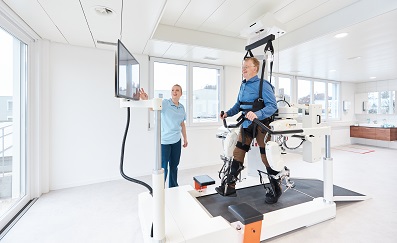Innovations in stroke: contributing to the Stroke Rehab Times special report
News
Summit Medical and Scientific were pleased to contribute to the latest special report by the Stroke Rehab Times, which examined the latest innovations in stroke rehabilitation technology and care.
Read the full article about innovations in stroke here.
Eight years ago, the Surrey-based company started partnering with world-leading developers to bring the highest quality rehabilitation equipment to customers across the UK.
It must be exciting to work in this rapidly-evolving field. How have stroke rehabilitation systems evolved over the past decade?
There have been huge advances in rehabilitation technology in the last decade, with new and exciting products coming on to the market every year.
Therapists can achieve results that they couldn’t reach before.
Integrating evidence-based technology that influences neural plasticity, motor learning and behaviour change is key to supporting patients in their motor recovery.
We want to help therapists embrace technology for stroke recovery, and we partner with the world’s best to provide state-of-the-art rehabilitation equipment.
We want to help therapists change lives and achieve the best possible results for their patients across the UK.
One of our favourite devices, the Lokomat, has actually been around for over 20 years – although it is still evolving even today.
Switzerland-based robotics developer Hocoma have used the knowledge from over 400 studies and over 1,000 Lokomats installed worldwide to develop the LokomatPro Sensation.
What makes the Lokomat superior to traditional rehabilitation and gait therapies?
With traditional manual gait training it is not possible to achieve the high number of repetitions and effort required to achieve the intensity that follows research principles of neuroplasticity in physical rehabilitation.
This is why robotic gait training is a recommendation in National Guidelines for Stroke.
It is also difficult to avoid compensatory movement, during support by therapists or the use of walking aids.
Patients and therapists are exposed to physical strain, even the risk of injury, which is why multiple therapists are typically required to support patients.
This is inefficient and results in a gait pattern that is neither reproducible nor physiologically correct and unlikely to achieve intensity within the NICE 45 minute quality standard.
With the Lokomat, all these limitations are not applicable. Even severely impaired patients can use it, allowing therapy to start in the early stages of recovery.
Robotic gait training with the Lokomat empowers patients with highly intensive, highly effective training.
Patients can achieve hundreds, or even thousands, of steps with just one therapist in a safe and enriched environment.
Real-time feedback, in-depth reporting and a catalogue of engaging exercises helps challenge patients beyond their present capabilities and inform their therapy plan.
The FreeD module that comes with the LokomatPro improves therapy even further by allowing for lateral translation and transverse rotation of the pelvis.
Patients can shift their weight completely over the stance leg, activating their core muscles and experiencing balance.
The new LokomatPro Sensation provides feedback to the patient so they can feel and understand the effort they are making, which further stimulates neural feedback to the brain.
How has the Lokomat improved with the LokomatPro Sensation?
When providing intensive gait training, keeping the patient motivated and engaged is a key component for their recovery.
The LokomatPro Sensation features three special improvements which enhance the patient’s experience, making therapy sessions more fun and personalised for them than ever before.
For the therapist, having more customisable exercises helps their patients push beyond their current capabilities, keeping the patient challenged and getting the most out of each session.
Intelligent algorithms provide adaptive robotic gait support, allowing the patient to feel the support being given as well as experiencing their performance.
This is a revolution for assist-as-needed therapy.
Music and auditory cues are synched with game-like exercises and challenges, boosting motivation, engagement and enrichment for the patient.
Finally, new therapy programs and expansions to existing exercises are offered to individually shape training and see vital progress in real-time.

